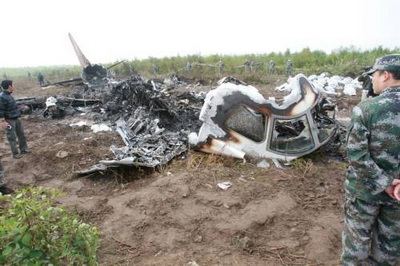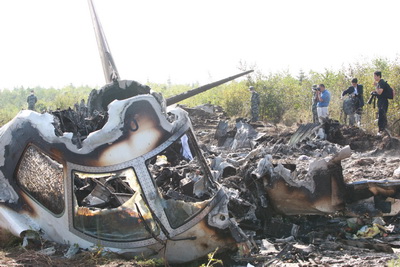Virtual Airlines: The Story Behind the Yichun Plane Crash
Corporation, page 28
Issue 484, August 30, 2010
Translated by Tang Xiangyang
Original article: [Chinese]
While other airlines had already cancelled evening services from Harbin to Yichun, an airline captain from Henan Airlines attempted to fly the route for the first time on August 24. The plane ended up crashing as it attempted to land at Yichun's small Lindu airport, the crash claimed the lives of 42 passengers and another 54 were injured.
Although responsibility for the crash is being placed at the feet of Henan Airlines, we should also scrutinize the involvement of the "Heilongjiang Virtual Regional Airline" (黑龙江支线模拟航空公司 Hēilóngjiāng Zhīxiàn Mónǐ Hángkōnggōngsī), a company backed by the Heilongjiang Airport Group, the provincial government of Heilongjiang and several city-level governments, including the Yichun Municipal government.
The Crash
The fateful Henan Airlines flight VD8387 that took off from Harbin that evening, was only the seventh evening flight that the airline had flown from the capital of Heilongjiang to Yichun. The airline only began flying the route on August 10 and offered services on Tuesdays, Thursdays and Saturdays.
China Southern Airlines was the first airline to offer an Harbin-Yichun service, including evening flights, but after flying the route for a period of time, the airline changed all evening flights to day flights for safety reasons.
According to a security report of the Heilongjiang branch of Southern Airlines released in August 2009, due to seasonal weather conditions and the location of the newly-constructed Yichun Lindu Airport, they concluded that it was not safe to offer night flights along the route. Southern Airlines decided that, as of September 1 that year, they would no longer fly the route at night.
However, at 20:51 on August 24, Qi Quanjun, a pilot with Henan Airlines took off in an E-190 aircraft, this was Qi's first flight along the route. When coming in to land at the Yichun airport at about 9.30pm in poor conditions that reduced visibility to less than 300 meters, the plane crashed 690 meters short of the runway. According to the official government report, 42 passengers died and another 54 were injured in the crash. The pilot was badly injured but did not die. Many of the original media reports stated that 43 passengers had died, but authorities have since confirmed that only 42 people died in the crash.
The day after the accident, all of Henan Airlines' fleet of E-190 aircraft were grounded and the general manager of the company was removed from his position.
A "Virtual" Regional Airline
What role did the "Heilongjiang Virtual Regional Airline" play in the crash? This "virtual" airline is not a regular airline, but something more akin to a charter company whose investors include the Heilongjiang Airport Group, the provincial government of Heilongjiang and several city-level governments, including the Yichun Municipal government. All the routes flown by the "virtual" airline are minor routes that the company has designed and mapped out for themselves, they also rent aircraft and crew to service the routes.
The plane that crashed on the evening of August 24 had been rented by this "virtual" airline to fly the Harbin-Mohe and Harbin-Yichun routes.
The "virtual" Heilongjiang Regional Airline is responsible for designing routes, marketing and renting airplanes. Cooperative airline companies provide and maintain the airplanes and crew.
An anonymous source from Heilongjiang Airport Group compared the process to renting cars. "Whether you want airlines to Yichun or to Russia, I will pay for them. I am responsible for nothing else."
The "virtual" airline company pays a rental fee to the airlines in order to guarantee that the airline company will make a profit from flying these less commercially viable routes. Sometimes they also draft a contract that divides up any profits made from ticket sales according to a settled ratio. 
A Dilemma for Regional Airlines
The biggest concern for regional airlines are safety risks. Most aircraft that have been rented to fly remote routes, their capacity of these smaller airports, which are often outside the web of established routes flown by the larger airlines, means that the ability to accommodate crews and provide maintance to the aircraft is weaker. The captains are also unfamiliar with local weather conditions and are likely to fly too many hours during the high season. These all add up to maker regional airlines more risky, the main reason why major airline companies are reluctant to operate regional airlines.
Aside from risk factors, regional airlines also have high costs but low profitability. Without the offer of subsidies from local governments, regional airlines find it difficult to make money.
Before the "virtual" Heilongjiang Regional Airline Company began operating in May, airline companies that had been offering services connecting Harbin to Mudanjiang, Jiamusi, and Jixi gradually pulled out of the market, forcing the local governments in the region and the Heilongjiang Airport Group to put up the money needed to rent aircraft from airline companies including Henan Airlines in order to keep the services running.
The Heilongjiang Provincial Government provided nearly 40 million yuan in subsidies to regional airline companies in 2009 and removed the landing fee for airlines connecting Harbin to other regional airports. But airline companies were still reluctant to operate the regional routes in the region.
This lack of commercial interest gave birth to the "virtual" airline company, which was based on a model that first existed in Inner Mongolia.
The Heilongjiang Virtual Regional Airline Company began flying on May 15 and provided regional flights connecting Harbin to Mudanjiang, Jiamusi, Jixi, Mohe and Yichun.
The number of air passengers travelling to the region increased noticeably when compared to the same period last year. The volume of passenger traffic to Jiamusi increased by 30%.
Wang Weiyu, deputy general manager of the Heilongjiang Airport Group, said that the company planned to develop the "virtual" regional airlines market over the next three to five years.
The general aim is that once the regional routes become commercially viable, the company plans to return it to the regular airline companies. The Airport Group planned to rent the planes for a year and then take a look at the situation before deciding on whether they wanted to continue with the model.
However, less than three months after the company was founded, and only 2 weeks after they started flying services between Harbin and Yichun, the Yichun crash occured.
From August 25, the Helongjiang Virtual Regional Airline Company decided to cease flights for three days in order to assess the situation.
Who Owns Henan Airlines?
The Yichun plane crash has been yet another heavy blow to the struggling Henan Airlines.
The original name of Henan Airlines was Kunpeng Airline Co. Ltd. Kunpeng was founded by Shenzhen Airlines in October 2007, and was controlled by Li Zeyuan. Though it announced a registered capital of 500 million yuan, the real figure was estimated as being closer to 100 million yuan.
At that time, though Shenzhen Airlines was suffering a shortage of funds, it still expanded its business coverage across the country. Kunpeng Airlines was a platform for the development of a regional airline and a tool for the airline to initiate contact with local governments and obtain capital and land support.
According to an anonymous source, Kunpeng Airlines intended to register in Beijing and cooperate with the Beijing Government but eventually the plan fell through. Then, Li Zeyuan registered Kunpeng Airlines in Xian, the capital of Shaanxi.
However, since the market for regional airlines was undeveloped, it remained hard for airline companies to earn a profit of regional routes, Kunpeng Airlines experienced difficulties. According to media reports, not long after its founding, its former shareholder, Mesa Air Group, sold its shares in the company for 3.6 million US dollars, taking a loss on it original investment of 5.8 million US dollars. The company also reclaimed five CRJ-200 planes that it had rented to Kunpeng Airlines.
In December 2007, Kunpeng Airlines signed a contract with the AVIC 1 Commercial Aircraft Co. Ltd to buy 100 China-made ARJ21 planes; in the following year, it purchased from Embreaer in Brazil 100 E-190 aircrafts.
A high-level executive from a Chinese airline company called it "mischief" (胡闹 húnào) for Kunpeng Airlines to purchase so many planes, especially when the ARJ21 plane was still under development.
In 2008, Kunpeng Airlines signed an agreement with the Henan government and moved its headquarters from Xian to Zhengzhou. It opened up routes that connected Zhenzhou to other large- and medium-sized cities across the country. It also promised to expand by buying over ten planes every year until it's total fleet expanded to 200 in 2016. But up until now, the airline owns only five E-190 planes, that includes the one that crashed in Yichun.
It had been reported that Li Zeyuan and the Henan government had agreed that the government would transfer 49% of its shares to Li and change the name of Kunpeng Airlines to "Henan Airlines". In January, Kunpeng Airlines officially became Henan Airlines. But, by all accounts, the Henan government is yet to invest any money into the airline.
Li Zeyuan was detained last November on charges of involvement in economic crimes. Air China raised its share in Shenzhen Airlines from 25% to 51% and became its controlling shareholder in March, which means, by extension that Henan Airlines now belongs to Air China, too.
However, up until now, both Air China and Shenzhen Airlines have remained silent on whether Henan airlines will continue with the same business strategy pursued by Li Zeyuan.
After the crash on August 24, Shenzhen Airlines issued a news release the following morning. In the original press release the company referred to itself as the "controlling shareholder of Henan Airlines" after a few minutes, an edited version of the press release was released in which the company was now referred to as simply an "associate shareholder in Henan Airlines.
At the news briefing held by the Henan government on August 25, Wu Zhenkun, the spokesman of the news office of the Henan Civic Airlines Development Commission said, "the Henan government is not a shareholder of Henan Airlines nor has it played any role in running and managemnet of the airline."
This article was edited by Ruoji Tang and Paul Pennay
Links and Sources
State Administration of Work Safety: 2010年8月23日—29日安全生产简要情况
The views posted here belong to the commentor, and are not representative of the Economic Observer |
Related Stories
Popular

- EUROPE
- Interview with Jean Pisani-Ferry and Nicolas Veron
- We talk to two experts from the Brussels-based European think thank Bruegel
Interactive
Multimedia

- EEO.COM.CN The Economic Observer Online
- Bldg 7A, Xinghua Dongli, Dongcheng District
- Beijing 100013
- Phone: +86 (10) 6420 9024
- Copyright The Economic Observer Online 2001-2011
















